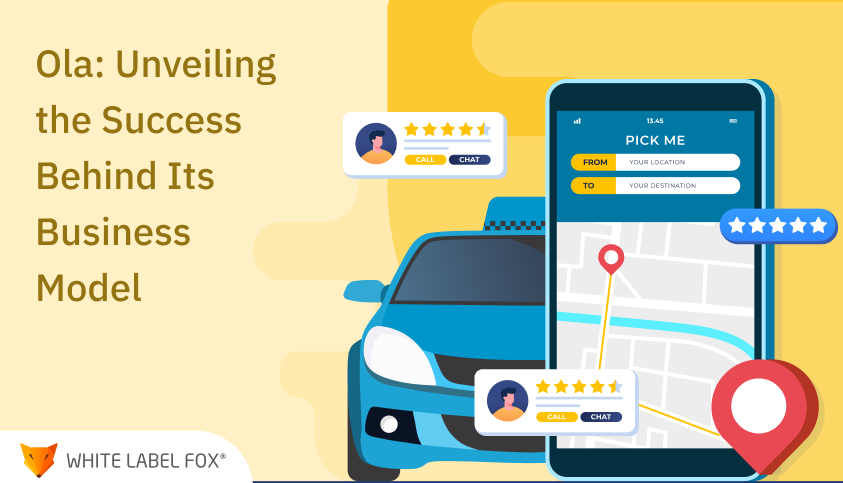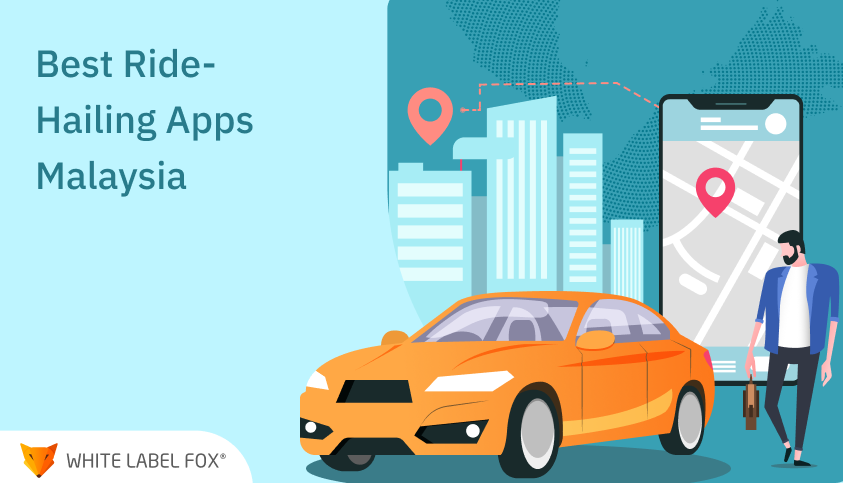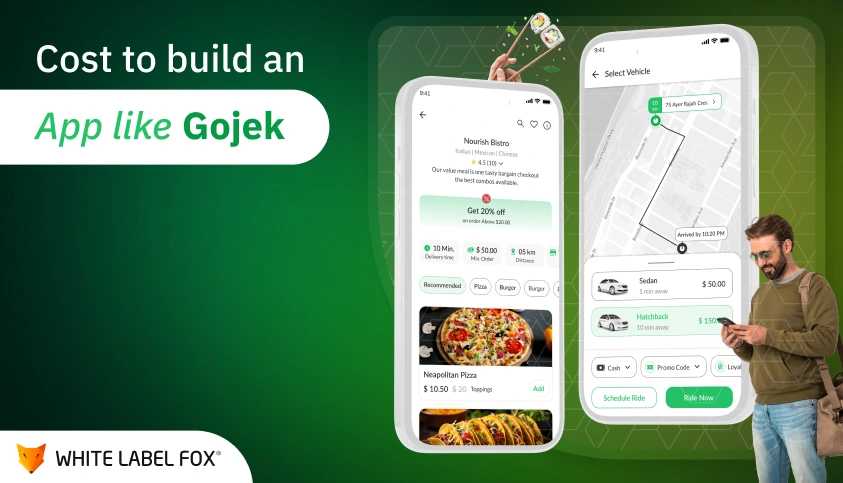When traveling from point A to B, many on-demand transportation services strike your mind. Undoubtedly, one such taxi booking service is Ola. It is a known ride-hailing service in India and a tough competitor of Uber. If you are considering starting a taxi-hailing service, unveiling the Ola business model’s success secret will help you make an intelligent footprint in a competitive market.
The company is also leading in the electric two-wheeler segment, Ola Electric. It sold around 35,000 units in May; the company measured its highest-ever monthly sales this month; Ola has captured a market share of above 30%. At the same time, Ola Cabs is also helping the company to make significant profits.
Are You Planning To Develop A Taxi Booking App Like Ola ?
Learn More About Our Readymade Clone Script

Looking at the company’s success, many are choosing to build an app similar to Ola. If you are one among them, dive deep into an Ola business model to know how it works and makes money. Keep reading the blog and find the success story of the ride-hailing business giant here.
What is Ola? Success Timeline to Dive into!
Ola is a multinational ride-sharing company. An Indian company is headquartered in Bangalore. Besides providing ride-hailing services, It also operates in other verticals, including cloud kitchens and financial services. Softbank is a prominent venture capitalist and has large stakes in the company.
Ola’s Success Story Timeline
Softbank has large stakes in Ola. The company extended its service overseas in Australia and New Zealand in 2018. In 2019, ride-hailing started its operations in the UK. Explore Ola’s success timeline to have a quick glimpse of everything.
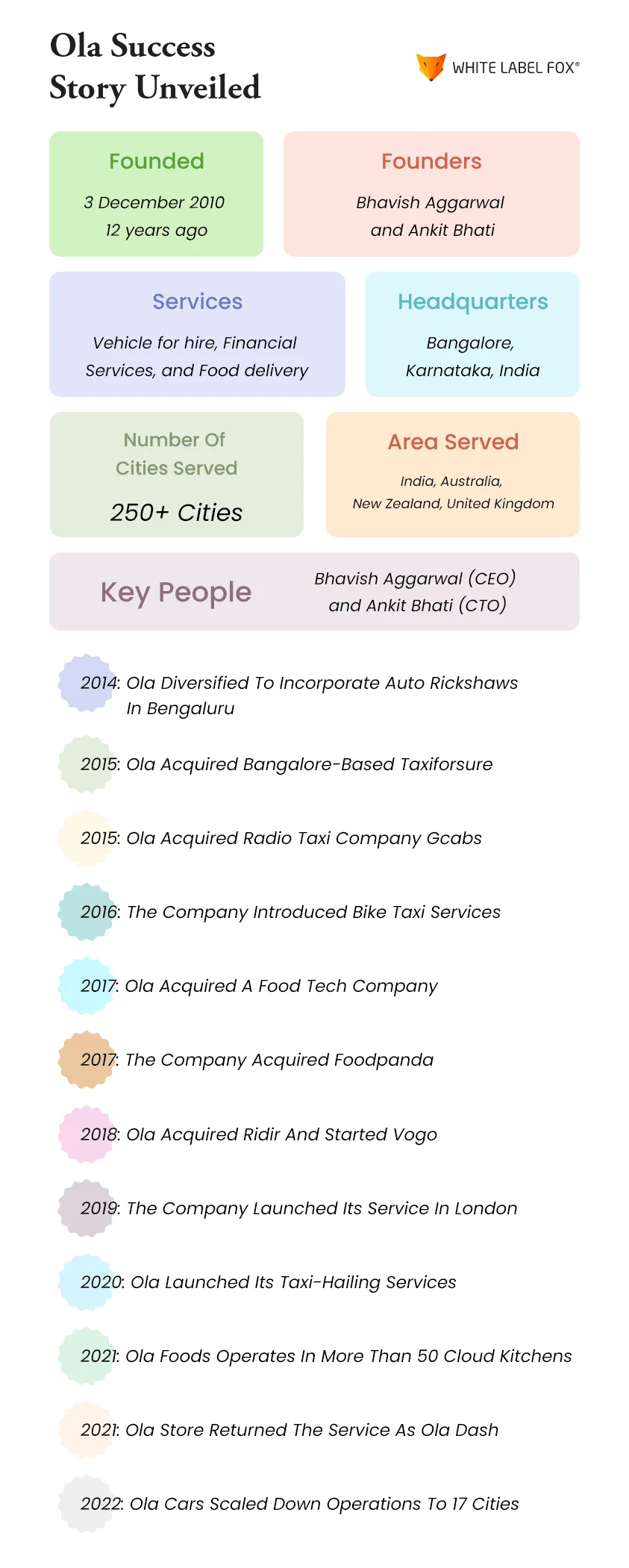
In 2019, Kia and Hyundai invested around $300m in India’s largest mobility service provider. An Ola business model is two-sided; the ride-hailing platform connects customers searching for transportation services with a driver via a mobile app.
The company serves millions of riders every day in 250+ cities. In 2022, the Ola Cabs app had over 23.6 thousand downloads in Australia. The company measured the highest downloads in 2019. There are almost 125 million Ola registered users. The company offers services in New Zealand, the UK, Australia, etc.
Ola Business Model: Check How the Ride-hailing Platform Works?
The digital revolution has changed the behavior of all people. Now people no longer have to wait for a taxi; they can book services with a few clicks on their smart devices. With Ola and other taxi-hailing services building their presence in the market, there is an excellent shift in customers’ mindsets and behavior.
Ola is an on-demand taxi-hailing service provider that has captured riders’ attention and interest and changed their preference over other public transportation.
The Ola business model incorporates a range of services beginning with transportation, like renting cabs to ride within the city, renting taxis for outstation round trips, and more.
Ola has sacked around 130 to 200 employees in a fresh round of layoffs. The layoffs are across the company’s electric vehicle, ride-hailing, and fintech businesses. The company has a net profit of 2 to 3% in Q3; Ola has experienced a jump in its profit. Read the Ola business model to know how it benefits riders, car owners, and many more.
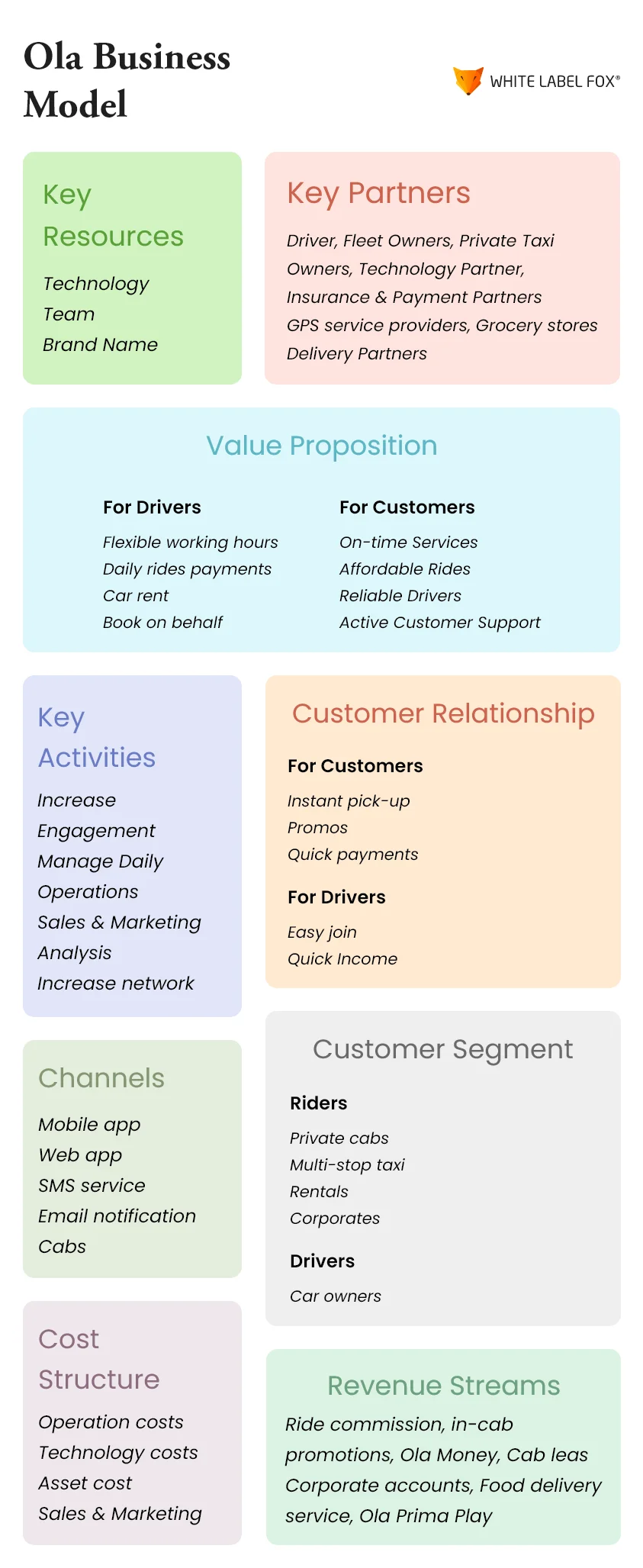
Ola’s Key Partners
Ola’s business model is not limited to riders. The company’s aggregator model has common partners such as car owners, drivers, manufacturers, and many more.
Ola’s Key Activities
The main activities of the company are to grow the business and acquire more customers. Ride-hailing company activities include:
- Managing regular operations by assuring safe rides.
- Management of technical platforms by checking the app.
- Marketing and sales to improve brand recognition both online and offline.
- Analysis of sales, daily rides, returns, etc.
Key Resources
- Manage rides and business.
- Data Analytics
- Team of sales, drivers, marketing, etc
- Ola’s brand name is Equity.
- Equity holders and fundraisers.
Value Proposition
For Riders
- Customers who are looking for on-demand rides with few clicks.
- Those people who are looking for flexible and inexpensive options.
- Riders can get access to amenities like WiFi, entertainment, and other tools.
- Great customer support
- No wait time
- Multiple stop structure is appreciating
- Multiple payment options, including cashless.
For Drivers
- Before acquisitions, drivers are asked to pass all necessary process
- Flexible riding hours
- Earning from rides
- Lease cars
- Providing 24*7 services
- Book services on behalf
Customer Relationship
The prolonged customer relationship is hard to drive for successful business operations in the long term and also in the competitive and changing industry. However, the Ola business model provides many channels to improve the experience and drive more customers.
Mechanized App
Ola provides all-time customer support and ride-hailing booking services through the app.
Discounts and Offers
Riders are provided with lots of benefits like discounts, offers, and more. Users also get some credit points as referrals.
Other Services
The ride-hailing services provide customers with a lot of benefits, such as multiple stops, a panic button for emergencies, etc.
Customer Segment
Ola Users
- Users can book rides to travel within the city.
- Customers who don’t like driving alone can book an Ola taxi to travel from point A to B.
Outspot Travel
Riders can book rides to travel outside of the city. They can go for a group vacation or a solo trip.
Rent a Car
Users can choose to drive on their own. They can book a taxi for 1 or 12 hours at their convenience.
Ola for Corporates
Managers or employees can book Ola for corporate to enjoy benefits like low cost, insurance, expenses, and more.
Ola Drivers
Drivers who have their own car, auto-rickshaw, bike, etc can drive and provide taxi services to customers.
Ola Revenue Model: How Does Ride-hailing Company Make Money?
You might have a glimpse of the Ola business model; now, let’s explore the Ola revenue model to know how the ride-hailing service provider makes money. Explore Ola’s revenue streams to know how it makes money.
Trip
Ola charges a certain percentage as a commission for each trip being carried out through the platform. Ola charges trip fares from riders through various factors based on car type, location, etc. The trip commission charges are based on:
- Base fare
- Distance per KM
- Ride time fare
- Wait time fare
- Peak pricing
- Advance booking fees
- Access fees
- Convenience fee
- Airport fees
- Tool and parking fees
- Cancellation fees
- Service Tax
Ola Money Wallet is credited to the driver’s account once the travel fare is charged for each ride. If the amount is paid in cash, the amount is included and deducted from the driver’s payment for each trip he has conducted.
The company also reduces the service tax. It charges a commission percentage; however, it pays the amount to the driver’s bank account within two days.
Ola’s estimated commission charges are as follows:
Introductory promotions: Around 7.5% commission for new drivers for a short time.
India: The company charges a 20% commission.
UK: The company charges 15% for Private Hire vehicles and 10% for metered taxis.
New Zealand: Ola charges an 18% commission
Australia: Ola charges 15 to 22% commission.
Ola Money
The company has introduced its wallet just like FreeCharge and Paytm wallets. With Ola virtual wallet service, payments can easily be made at multiple vendor touchpoints. The waller incorporates its cab-hailing services, contributing to Ola’s revenue.
Advertisement and In-cab Promotions Commissions
Ola charges a commission for promotions. Commuters are provided access to pamphlets, brochures, and other advertising tools. Besides, live-streaming ads are played to promote various companies products and services.
Cab Leasing Program
The ride-hailing company has started a cab leasing program for driving partners. Ola purchases cars and leases them to drivers to improve drivers’ loyalty towards Ola. A daily amount of 700 to 1150 is charged to drivers for running vehicles. It can be an aggregate of trip-based and fixed commissions.
Ola Credit Card
“Ola Money SBI card” has been introduced by the company in association with Visa and SBI. The credit card provides lots of benefits and rewards to users.
Corporate Accounts
Ola provides lots of meetings with the head of multiple organizations where they promote the company and convince corporate employees and managers to use cabs for their business travels. Decreased fees are charges from the corporates with the increase in demand. Ola earns high sales volume with B2B tie-ups.
Delivery Service
With the acquisition of FoodPanda, Ola successfully entered into a delivery segment. The company is expected to take over Swiggy and Uber Eats, grow its revenue and build a strong position in the delivery market.
Ola Prime Play
The company has partnered with Sony Liv, Microsoft, Audio Compass, Apple Music, and more to provide commuters with in-cab personalized entertainment. The company makes money on some rides providing entertainment services and charges 20 ₹ as a convenience fee.
Ola Electric Helps Company to Drive Great Revenue!
Ola Cabs introduced Ola Electric, helping the company to create batteries under BaaS (Battery-as-a-service) and electric vehicles model for shared mobility. The company’s CEO plans to recruit almost 2,000 people to deliver the project. Its demand for batteries and electric cars in upcoming years makes Ola Electric one of the largest future revenue streams for the company.
Ending Note
Now you might have insight into the Ola business model, revenue streams, and more. The taxi-based model helps the company to serve improved services to its platform users. Ola is the ultimate solution for many who are looking to reach their desired destination without any delays. The company has really redefined the way of traveling for billions of people.
If you are thinking of starting on-demand ride-hailing services, you have made the right choice. White Label Fox can help you start your own ride-hailing online services at affordable development costs.
Specify your requirements and let us perform the rest. We provide a comprehensive package that includes the essential features required for a successful ride-hailing app, such as user registration, real-time tracking, payment integration, ratings and reviews, and driver management. We also offer more features and customization options based on your specific requirements.
Whether you are a startup or an existing business looking to enter the ride-hailing market, White Label Fox can help you bring your vision to life. Our expertise in app development, coupled with their ready-made solution, can significantly accelerate your time to market and give you a competitive edge.
Frequently Ask Questions
Ola is an Indian ride-hailing company that provides transportation
services via its mobile application. It offers various ride options,
including cabs, auto-rickshaws, and two-wheelers, for passengers to book
rides with the convenience of their smartphones.
Ola works by connecting passengers with drivers through its mobile
application. Users can book rides by selecting their location, desired
ride type, and payment option. Once a ride is booked, the app matches
them with the nearest available driver, who picks them up and takes them
to their destination.
Ola operates on a platform-based business model, connecting customers
(passengers) with service providers (drivers). It generates revenue by
taking a commission from the fare charged to the customer for each ride,
and by offering additional services such as Ola Rentals, Ola Shuttle,
and Ola Money.
Ola provides various ride options to cater to different customer needs,
including:
- Ola Micro: Affordable small car rides for individuals or
small groups.
- Ola Mini: Budget-friendly compact cars.
- Ola Prime: Premium rides with high-end vehicles.
- Ola Rentals: Offers hourly rentals for people who need a
car for an extended period.
- Ola Auto: Auto-rickshaw rides for short trips.
- Ola Bike: Two-wheeler rides for faster and cheaper
travel.
- Ola Shuttle: A shared ride option for daily commuters,
providing scheduled routes.
- Ola Micro: Affordable small car rides for individuals or small groups.
- Ola Mini: Budget-friendly compact cars.
- Ola Prime: Premium rides with high-end vehicles.
- Ola Rentals: Offers hourly rentals for people who need a car for an extended period.
- Ola Auto: Auto-rickshaw rides for short trips.
- Ola Bike: Two-wheeler rides for faster and cheaper travel.
- Ola Shuttle: A shared ride option for daily commuters, providing scheduled routes.
Ola makes money primarily through the following revenue streams:
- Ride Commissions: Ola charges a percentage-based
commission from the driver-partners for every ride booked
through the app.
- Surge Pricing: During peak hours or high demand, Ola
increases fares, allowing it to make more revenue.
- Subscription Plans: Ola offers subscriptions like Ola
Select and Ola Money, which provide various benefits to frequent
riders.
- Business Solutions: Ola also generates revenue by
offering corporate ride solutions to businesses, facilitating
employee transportation.
- Value-added Services: Ola provides services like Ola Play
(in-car entertainment) and Ola Money (digital wallet), adding to
its revenue.
- Ride Commissions: Ola charges a percentage-based commission from the driver-partners for every ride booked through the app.
- Surge Pricing: During peak hours or high demand, Ola increases fares, allowing it to make more revenue.
- Subscription Plans: Ola offers subscriptions like Ola Select and Ola Money, which provide various benefits to frequent riders.
- Business Solutions: Ola also generates revenue by offering corporate ride solutions to businesses, facilitating employee transportation.
- Value-added Services: Ola provides services like Ola Play (in-car entertainment) and Ola Money (digital wallet), adding to its revenue.
While both Ola and Uber operate in the same ride-hailing space, Ola’s
business model stands out in several ways:
- Market Focus: Ola initially focused on the Indian market
and emerging countries, while Uber expanded globally from the
beginning.
- Diverse Ride Options: Ola provides a wider range of ride
options, including auto-rickshaws and bikes, which appeal to the
local demographic in India.
- Partnership with Government: Ola has also partnered with
government transportation programs and vehicle leasing services,
whereas Uber does not emphasize these partnerships as much.
- Market Focus: Ola initially focused on the Indian market and emerging countries, while Uber expanded globally from the beginning.
- Diverse Ride Options: Ola provides a wider range of ride options, including auto-rickshaws and bikes, which appeal to the local demographic in India.
- Partnership with Government: Ola has also partnered with government transportation programs and vehicle leasing services, whereas Uber does not emphasize these partnerships as much.
Ola’s revenue model has been key to its success by diversifying income
streams beyond just ride commissions. This includes:
- Offering Various Ride Options: Ola's ability to cater to
different budgets and needs has helped it capture a larger
market share.
- Subscription Services: Ola Select provides premium
services, which attract loyal customers willing to pay extra for
enhanced experiences.
- Ola Money: Its integrated digital wallet adds a unique
layer of monetization, improving customer retention and
convenience.
- Offering Various Ride Options: Ola's ability to cater to different budgets and needs has helped it capture a larger market share.
- Subscription Services: Ola Select provides premium services, which attract loyal customers willing to pay extra for enhanced experiences.
- Ola Money: Its integrated digital wallet adds a unique layer of monetization, improving customer retention and convenience.
Technology is central to Ola’s business model. The company uses a robust
app-based platform that allows:
- Real-Time Ride Matching: Ola uses GPS and algorithms to
match passengers with drivers in real-time.
- Surge Pricing: Ola’s dynamic pricing algorithm adjusts
fares during high demand, helping manage supply and demand
effectively.
- Safety Features: The app includes safety features like
ride tracking, SOS buttons, and driver background checks.
- Payment Integration: Ola’s platform integrates with
multiple payment gateways, including digital wallets, to ensure
seamless transactions.
- Real-Time Ride Matching: Ola uses GPS and algorithms to match passengers with drivers in real-time.
- Surge Pricing: Ola’s dynamic pricing algorithm adjusts fares during high demand, helping manage supply and demand effectively.
- Safety Features: The app includes safety features like ride tracking, SOS buttons, and driver background checks.
- Payment Integration: Ola’s platform integrates with multiple payment gateways, including digital wallets, to ensure seamless transactions.
Ola attracts and retains customers through several strategies:
- Competitive Pricing: Ola offers affordable and flexible
pricing options for all its ride services, making it accessible
to a wide range of customers.
- User Experience: The app is designed to be easy to use
with features like ride tracking, pre-booking, and fast payment
options.
- Customer Support: Ola offers 24/7 customer support to
resolve any issues quickly and efficiently, enhancing customer
satisfaction.
- Loyalty Programs: Through Ola Select and other loyalty
programs, the company rewards frequent riders, building
long-term relationships with customers.
- Competitive Pricing: Ola offers affordable and flexible pricing options for all its ride services, making it accessible to a wide range of customers.
- User Experience: The app is designed to be easy to use with features like ride tracking, pre-booking, and fast payment options.
- Customer Support: Ola offers 24/7 customer support to resolve any issues quickly and efficiently, enhancing customer satisfaction.
- Loyalty Programs: Through Ola Select and other loyalty programs, the company rewards frequent riders, building long-term relationships with customers.
Ola faces several challenges, including:
- Competition: Ola competes directly with global giants
like Uber, as well as local taxi services, which could
potentially lead to price wars.
- Driver Partner Issues: Ola needs to maintain good
relationships with its driver-partners while ensuring their
profitability. Issues related to earnings, driver shortages, and
fairness in commission charges are ongoing challenges.
- Regulatory Hurdles: Ride-hailing services often face
scrutiny and regulatory challenges from local governments and
authorities, affecting operations in some regions.
- Customer Trust: As a tech-based company, ensuring data
privacy and the safety of riders and drivers is crucial, and any
breaches could impact trust.
- Competition: Ola competes directly with global giants like Uber, as well as local taxi services, which could potentially lead to price wars.
- Driver Partner Issues: Ola needs to maintain good relationships with its driver-partners while ensuring their profitability. Issues related to earnings, driver shortages, and fairness in commission charges are ongoing challenges.
- Regulatory Hurdles: Ride-hailing services often face scrutiny and regulatory challenges from local governments and authorities, affecting operations in some regions.
- Customer Trust: As a tech-based company, ensuring data privacy and the safety of riders and drivers is crucial, and any breaches could impact trust.

